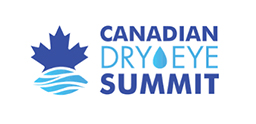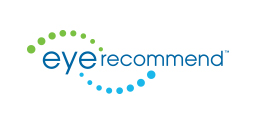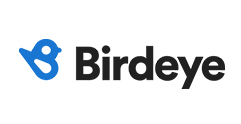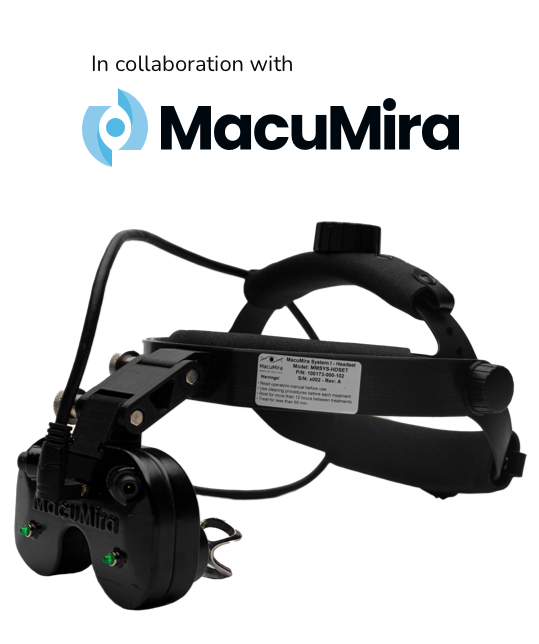On average, 165 people who live near your optometry practice are using Google to search for a new eye doctor every day. In order to optimize your chances of attracting the attention of those potential customers, you want to stand out.
Go to Google right now and search for an optometrist. Does your practice show up? If it does, is it displayed prominently or buried amongst other similar practices all vying for your customer’s attention?
If you had to sift to find your practice chances are your potential customers do too. This article aims to help you better improve your chances of reaching one of those 165 potential daily customers.
The Anatomy of a Google Search Engine Results Page
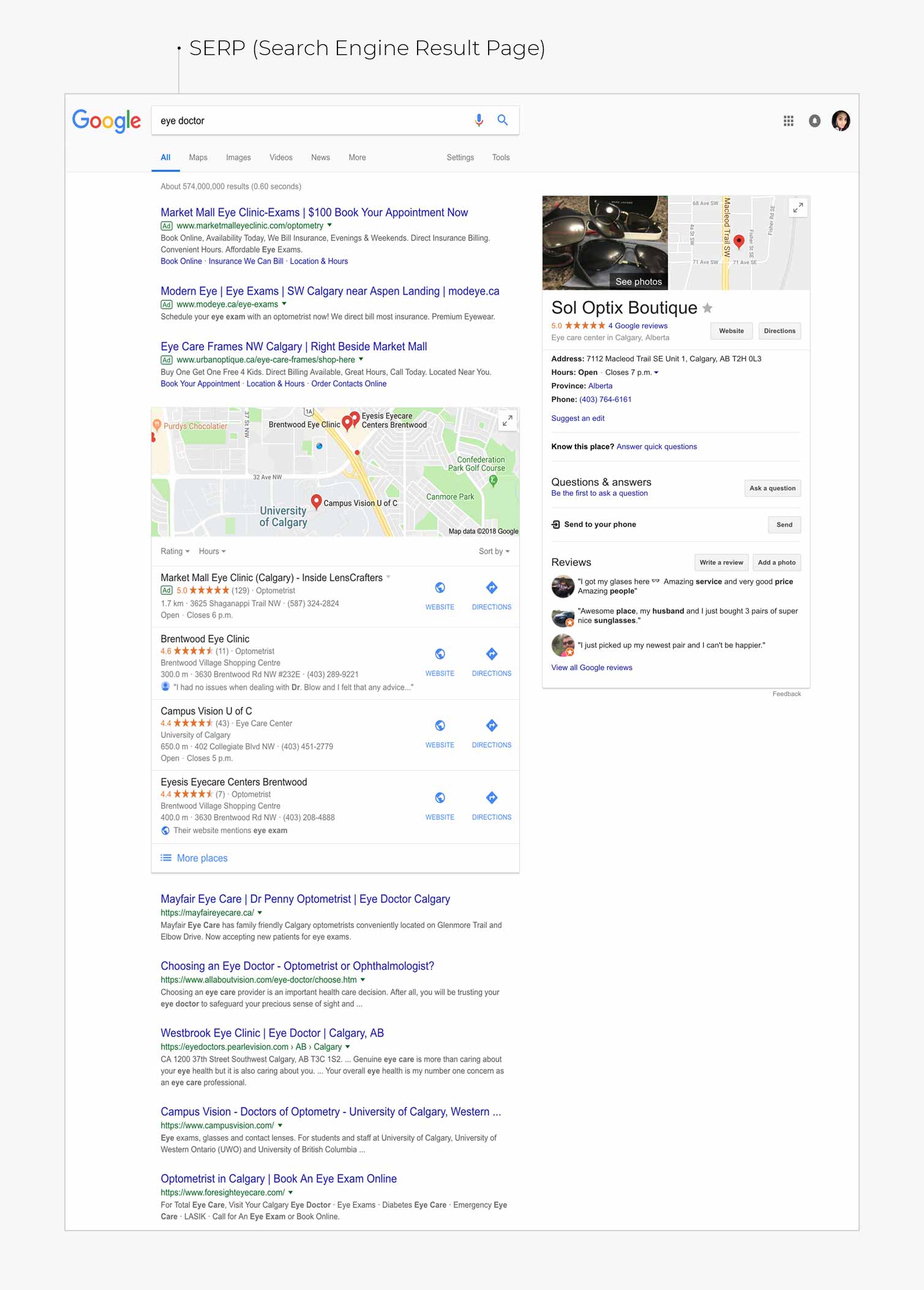
Whenever someone searches for an optometrist on Google the search engine presents them with a search engine results page (SERP). Each page has three different sections where your practice might show up: Google Ads, Google Maps, or organic results.
Google Ads
Ads are found at the top of the SERP and are placed there through the Google Ads program, formerly called Google Adwords. Google Ads works by having advertisers bid on ad placements related to specific keywords such as “optometrist” or “eye doctor”.
If you choose to advertise through Google Ads your practice will be charged when (and only when) a user chooses to click on your ad. The higher the position of your ad on the list the more money you will have to pay when it is clicked upon.
On desktops, Google returns a maximum of four ads above the rest of the search results, compared to the three ads that it shows on mobile devices. Once a potential customer clicks on your ad they are taken to your website, where they hopefully call your business or fill out an appointment request form.
Google Maps
Below the ads section is the map, which features four practices located within close proximity to the person conducting the search, and the top featured practice is placed on the map through the Google Ads program. These listings show the user Google reviews, directions from their current location, and other useful information. This gives the user a chance to quickly evaluate the eye care options nearest to them.
Organic Results
The third and final portion of the SERP is the organic results section. This section lists all of the websites Google things the user might be interested in and prioritizes these results based on an ever-changing algorithm. Google is constantly refining their algorithm to better serve its users and give them the best possible searching experience.
Using Google Ads
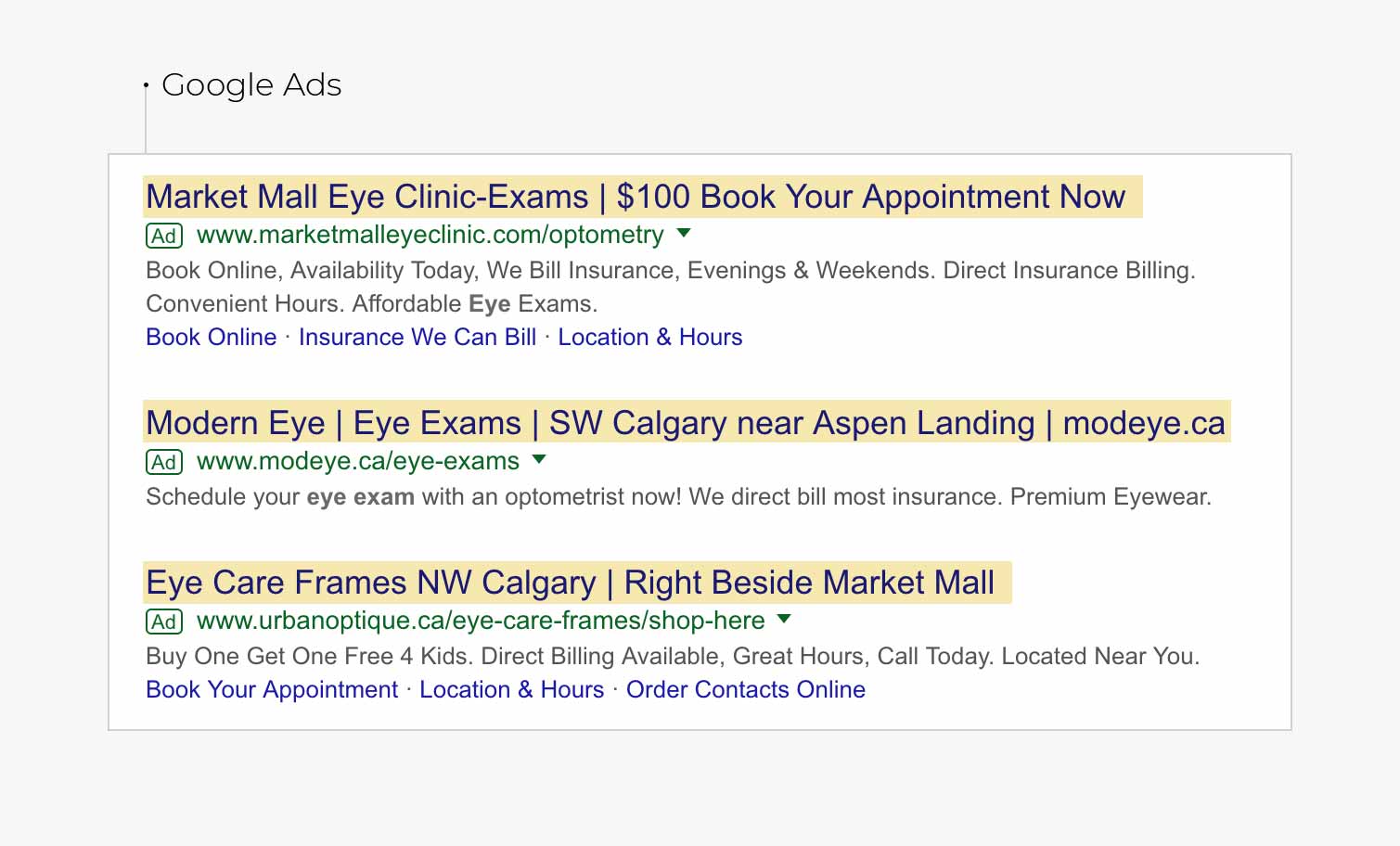
As we previously discussed one way you can ensure that your business is prominently displayed at the top of the search page is to pay to be there through the Google Ads program. Google Ads is easy to set up and use. However, if you are serious about paying money to acquire patients in a profitable manner you may want to consider hiring a Pay-Per-Click (PPC) advertising expert to manage and optimize your ads.
The Clickthrough Rate
Most people think that no one actually clicks on the Ads, but instead skips down to the maps and organic search results sections of the search page. However, I have looked at the data of over 100 optometrist’s Google Ads accounts and reviewed the click-through-rate data first hand and I found some surprising results.
Across all four ad slots on each page close to 10% of users clicked on the ads. Out of the average 165 searches for optometrists done per day, that means that 16.5 people clicked on one of the ads per day.
Calculating the Profitability
You may be wondering how much those possible 16.5 customers will cost you to acquire, and whether or not this solution is profitable. Let’s go through the math together:
A practice whose ad shows up in the top ad position during a search in a moderately competitive eye care environment should expect to pay about $5. The average website manages to convert about 10% of all of its visitors (as opposed to a Marketing4ECPs website, which converts an average of 20% of its visitors). Conversion, in this context, means that one out of every ten people who visit your website will call you, fill out a form, or reach out to you in some other way.
Let’s look at our calculations:
If it costs $5 per click you will need to spend $50 to get ten clicks. Of those ten clicks, one will convert and reach out to your company either by calling your office or filling out an online form. Typically only one out of every three calls turns into a new patient, which means you will have to spend an average of $150 to get one new patient.
$150 sounds like a lot of money to pay for a single new patient, but if you consider the lifetime value of that client, including specialty services, merchandise sales, and other products you will easily recoup your $150 cost and gain a valuable client that will benefit your practice on an ongoing basis.
Optimizing Your Google Ads Spending
Having a great website or the ability to close deals well on the phone can drastically reduce that $150 cost. Many of my clients end up spending, on average, around $40 for each new patient they acquire.
Optimizing each ad is an art form and needs to be tailored to your practice, your location, and your potential client pool. However, there are a few things every optometry business can do to better optimize their Google Ads and reduce their investment costs.
Run Different Ads
Try three different ads for your business, each of which uses different messaging. Test them against each other and determine which ad performs the best. This test is simple to conduct because Google is configured to automatically favour the best performing ad and show it to more customers, thereby getting more conversions.
Use Top Performing Keywords
Top performing keywords such as “Optometrist near me” or “Optometrist in [Your city or neighbourhood]” will help you reach customers in your immediate area. Customers value convenience, so they are more likely to choose an optometrist that is near their home, office, or child’s school than one that is farther away.
My colleague Kate Chase has written a comprehensive blog post that offers more tips on how to best optimize your Google Ads.
Google Local (Maps)

As I mentioned previously customers value convenience, and are more likely to choose optometry offices that are close to places they already frequent. That is why Google Maps is one of the most valuable places for your practice to show up on a search results page. Google Maps only shows practices that are close to the user and favours practices with high reviews. Maps also shows the user what the practice’s Google review rating is, a practice that allows users to easily identify the best eye care professional in their area.
The key to helping ensure your business is prominently featured on Google Maps is authenticity. It is in Google’s best interest to only show real businesses that actually provide the goods or services the user is looking for. Here are a few tips to help your company become more prominently featured:
Have a Lot of Reviews
A good online reputation is critical to the success of any business. We all dismiss products that have poor reviews or lacklustre ratings, and our customers are no different. There are a variety of ways you can get more positive reviews, such as asking your front desk staff to prompt satisfied customers to leave a good review at the end of each appointment.
List on Other Directories
Google favours businesses that are listed on multiple directories. If they see that you are also listed on Yelp, the Yellow Pages, Facebook, or other directories it helps Google verify that you are an actual business. You should also make sure your information (such as address and office hours) is consistent across all directories. Make sure you avoid any typos or other small mistakes. If your practice is listed as “ABC Eyecare” on Facebook, but “ABC Eye Care” on your website Google will likely not understand that these two entities are the same business.
Verify Your Google Business Listing
Verifying your Google Business listing is another way Google separates the real businesses from the fake ones. The verifying process is usually done using a 6 digit code that is either sent to the phone number or email attached to your Google Business account or mailed out to your business as a postcard. The Google Business verification process is outlined in further detail here.
Choose Your Category Carefully
When selecting your category on Google you want to make sure you are covering all of your bases, but you also want to make sure you are targeting words that are more likely to be searched. Choose the “Optometrist” category over categories such as “Eye Doctor” or “Eye Care” as it is a more commonly used search phrase.
Include Appropriate Keywords
It is important to include words such as “optometrist” in the description section of your business listing, as well as words related to your location such as the province or city you are located in. This makes it more likely that your business listing is presented to users looking for optometrists in their area.
Organic Results
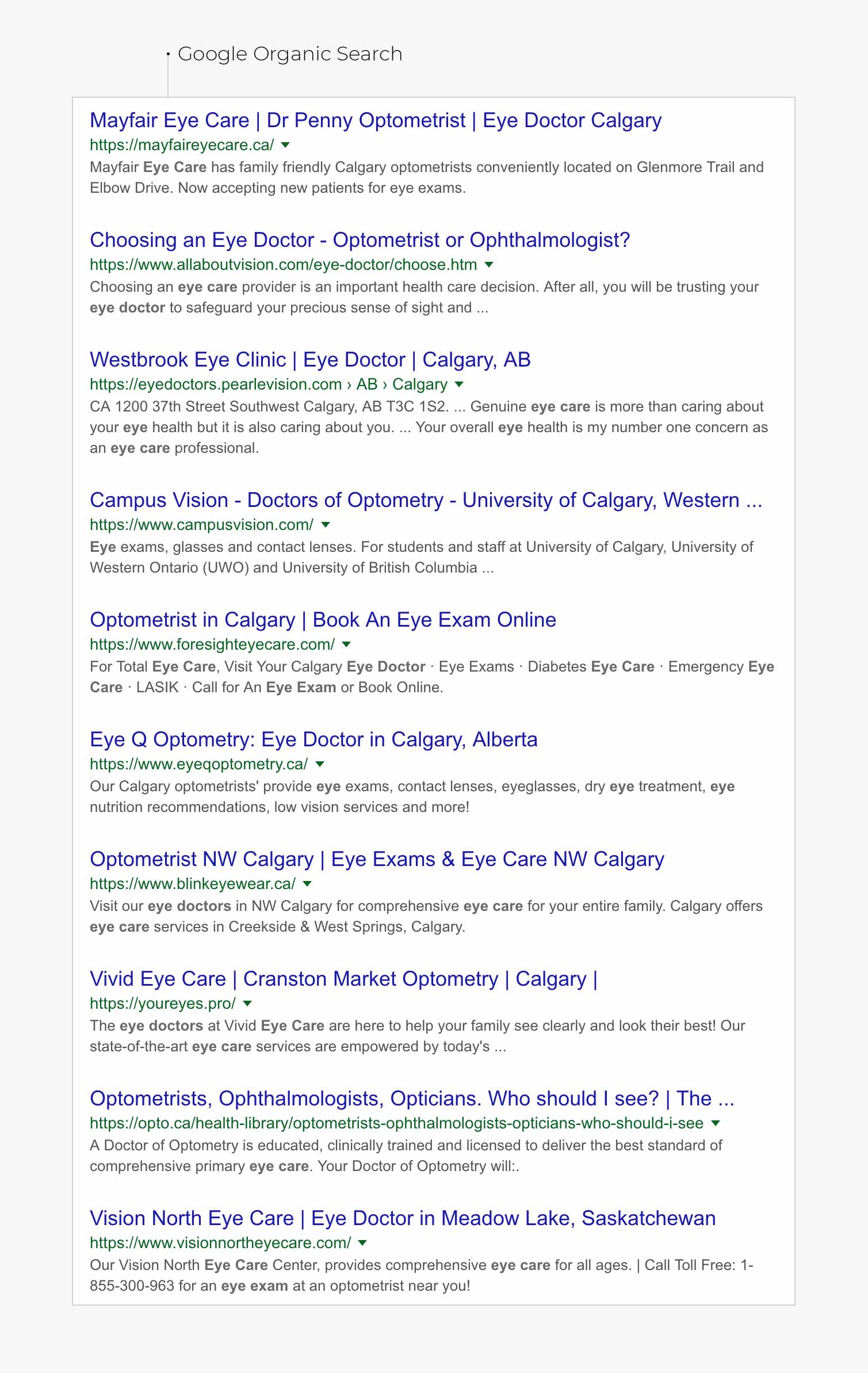
When someone mentions SEO what is the first thing that springs to mind? Most eye care professionals realize that SEO is important and needs to be done well, but may not necessarily understand exactly what it is. In order to craft a comprehensive, long-term SEO strategy you will need to work with an SEO specialist. However, there are a few things you can do today to help your business rank higher in Google’s organic search results.
Our resident SEO expert Cameron Martel offers a few simple SEO guidelines:
Create and Share Great Content
It is important that you educate people about your business, what specialty services you offer, and what sets you apart from the competition. This information helps them make informed decisions and choose the optometry practice that is best suited to meet their vision needs.
Make Sure Your Website is Multi-Device Friendly
A website that works great on a desktop but is clunky, or unusable, on a mobile device is going to severely limit the number of people you can reach effectively. Make sure your website is designed in such a way that your user experience is easy and enjoyable on all possible devices.
Make Sure Your Website is Easy to Navigate
Most users don’t want to waste time hunting for information, so make sure your website is laid out in such a way that your users can find important information (such as location, office hours, and services) easily.
Focus on Education
We trust people who teach us things. By educating your users you are not only helping them make informed decisions about their vision health you are also building a trusting relationship.
Step Into Your User’s Shoes
When someone comes to your website what do you think they are actually looking for? Make sure your website is intuitive to use, and that it is easy to find the information your users are looking for.
These five tips make up the foundation of any solid SEO strategy and will help you ensure your business listing doesn’t get lost amongst the weeds.
Conclusion
Most users turn to Google when they are searching for a new optometrist in their area. In fact, Google sees an average of 165 searches for optometrists per day. By understanding how Google sorts and ranks search results and implementing a few simple SEO strategies you can help your optometry practice stand out and gain new customers.












